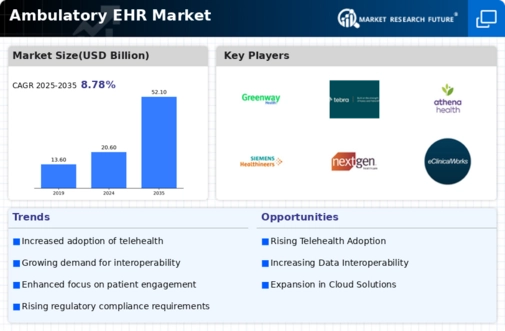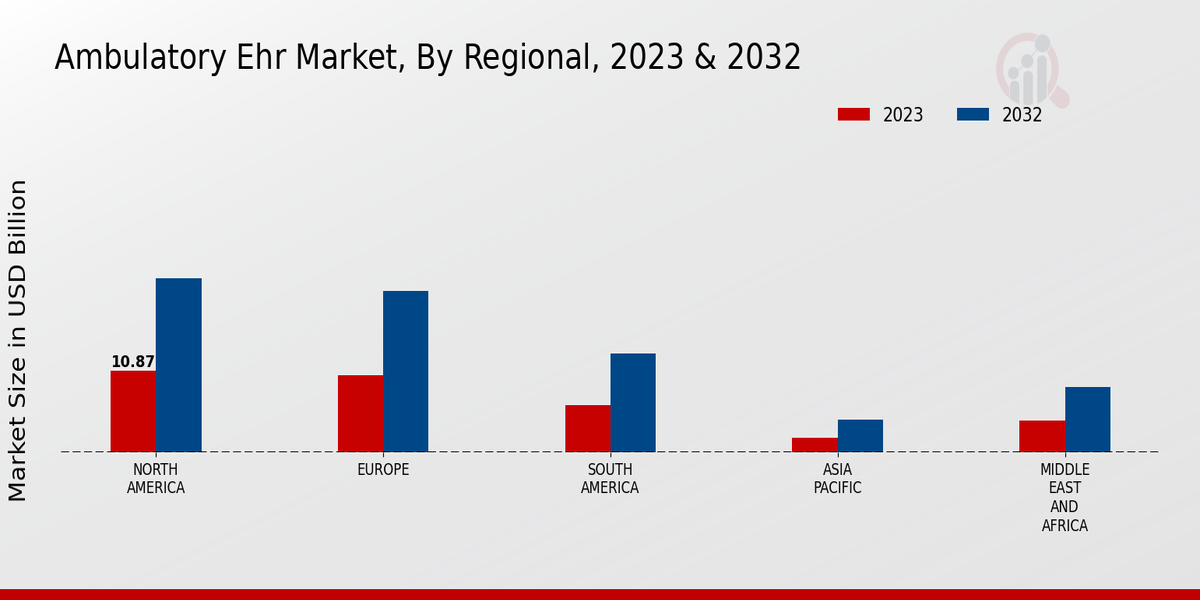Market Growth Projections
The Global Ambulatory EHR Market Industry is on a growth trajectory, with projections indicating a substantial increase in market size. In 2024, the market is expected to reach 20.6 USD Billion, and by 2035, it is projected to expand to 52.1 USD Billion. This remarkable growth reflects the increasing adoption of electronic health records across various healthcare settings, driven by factors such as regulatory support, technological advancements, and the rising demand for patient-centric care. The anticipated compound annual growth rate of 8.78% from 2025 to 2035 further underscores the potential for continued expansion in the ambulatory EHR market. This upward trend suggests a robust future for the industry as it adapts to the evolving needs of healthcare providers and patients alike.
Focus on Patient-Centric Care
The Global Ambulatory EHR Market Industry is increasingly aligning with the trend towards patient-centric care, which emphasizes the importance of patient engagement and satisfaction. Healthcare providers are recognizing that incorporating EHR systems can significantly enhance the patient experience by offering features such as online appointment scheduling, access to medical records, and personalized health information. This shift towards a more patient-focused approach is likely to drive the adoption of ambulatory EHR systems, as providers seek to improve patient outcomes and foster stronger relationships with their patients. As this trend continues, the market is set to expand, reflecting the growing emphasis on patient-centered healthcare delivery.
Regulatory Support and Incentives
Regulatory frameworks and government incentives play a pivotal role in the expansion of the Global Ambulatory EHR Market Industry. Governments worldwide are implementing policies that encourage the adoption of electronic health records, thereby enhancing interoperability and data security. For instance, initiatives aimed at promoting the use of EHRs in outpatient settings are becoming increasingly prevalent. These regulations not only facilitate compliance but also provide financial incentives for healthcare providers to transition to digital systems. As a result, the market is expected to witness a robust growth trajectory, with projections indicating a rise to 52.1 USD Billion by 2035, reflecting the positive impact of regulatory support on EHR adoption.
Technological Advancements in EHR Systems
Technological advancements are a key driver of growth in the Global Ambulatory EHR Market Industry. Innovations such as artificial intelligence, machine learning, and data analytics are transforming the capabilities of EHR systems, enabling healthcare providers to leverage data for improved decision-making and operational efficiency. These advancements not only enhance the functionality of EHR systems but also contribute to better patient care by providing actionable insights. As the industry evolves, the integration of advanced technologies is expected to attract more healthcare organizations to adopt ambulatory EHR solutions, thereby fueling market growth. The anticipated compound annual growth rate of 8.78% from 2025 to 2035 underscores the potential of these technological innovations.
Increasing Demand for Digital Health Solutions
The Global Ambulatory EHR Market Industry is experiencing a surge in demand for digital health solutions, driven by the need for efficient patient management and streamlined workflows. As healthcare providers increasingly adopt technology to enhance patient care, the market is projected to reach 20.6 USD Billion in 2024. This shift towards digitalization is not only improving patient outcomes but also reducing operational costs for healthcare facilities. The integration of EHR systems allows for better data sharing and communication among providers, which is essential in a rapidly evolving healthcare landscape. Consequently, the industry is poised for substantial growth as more organizations recognize the benefits of adopting ambulatory EHR systems.
Rising Need for Cost-Effective Healthcare Solutions
The Global Ambulatory EHR Market Industry is witnessing a growing demand for cost-effective healthcare solutions, as providers seek to optimize their operations while maintaining high-quality care. The implementation of ambulatory EHR systems can lead to significant cost savings by reducing paperwork, minimizing errors, and streamlining administrative processes. As healthcare costs continue to rise, organizations are increasingly turning to EHR systems as a means to enhance efficiency and reduce expenditures. This trend is likely to drive the market forward, as more providers recognize the financial benefits associated with adopting electronic health records. The industry's growth trajectory appears promising, with projections indicating a substantial increase in market size over the coming years.









